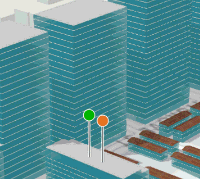PointSymbol3D is used to render features with Point geometry in a 3D SceneView. This symbol type is not supported in 2D MapViews.
A PointSymbol3D must include at least one symbol layer for it to render in the view. One or more of the following symbol layer types must be used to define a 3D point symbol:
| Symbol3DLayer Type | Flat/Volumetric | Size Units | Example |
|---|---|---|---|
| IconSymbol3DLayer | flat | points | |
| ObjectSymbol3DLayer | volumetric | meters |  |
| TextSymbol3DLayer | flat | points |  |
See Symbol3DLayer and Symbol3D to read more general information about 3D symbols, symbol layers and how they relate to one another.
var symbol = new PointSymbol3D({
symbolLayers: [new ObjectSymbol3DLayer({
width: 5, // diameter of the object from east to west in meters
height: 10, // height of object in meters
depth: 15, // diameter of the object from north to south in meters
resource: { primitive: "cube" },
material: { color: "red" }
})]
});Constructors
new PointSymbol3D(properties)
properties Object See the properties for a list of all the properties that may be passed into the constructor. |
Property Overview
| Name | Type | Summary | |
|---|---|---|---|
| Callout3D | Settings for adding a callout visualization to the symbol. more details | more details | |
| String | The name of the class. more details | more details | |
| Object | The origin of the style from which the symbol was originally referenced. more details | more details | |
| Collection | A Collection of Symbol3DLayer objects used to visualize the graphic or feature. more details | more details | |
| String | For PointSymbol3D the type is always | more details | |
| Accessor | Shifts the symbol along the vertical world axis by a given height. more details | more details | |
Property Details
calloutCallout3D
Since: ArcGIS API for JavaScript 4.4Settings for adding a callout visualization to the symbol. Callouts are drawn from the point feature location that is being symbolized, to the vertical offset of the symbol. This property has no effect if verticalOffset is not set. At the moment only callout of type line are supported. See LineCallout3D.
- See also:
Example:var symbol = new PointSymbol3D({ symbolLayers: [...], verticalOffset: ..., callout: new LineCallout3D({ size: 1.5, color: [150, 150, 150], border: { color: [50, 50, 50] } }) });declaredClassStringreadonly
The name of the class. The declared class name is formatted as
esri.folder.className.styleOriginObjectreadonly
The origin of the style from which the symbol was originally referenced. A reference to the style origin can be either by styleName or by styleUrl (but not both). This information is part of the WebScene persistence model and may be used to understand where a symbol was originally sourced from. It does not affect actual appearance or rendering of the symbol.
symbolLayersCollection autocast
A Collection of Symbol3DLayer objects used to visualize the graphic or feature.
typeStringreadonly
For PointSymbol3D the type is always
point-symbol-3d.verticalOffsetAccessor
Since: ArcGIS API for JavaScript 4.4Shifts the symbol along the vertical world axis by a given height. The height is set in screen space units like points or pixels. For points displayed with a callout
verticalOffsetshould be set.- See also:
Properties:screenLength NumberThe vertical symbol offset in points. This value may be autocast with a string expressing size in points or pixels (e.g.
12px).optionalminWorldLength NumberThe minimum vertical symbol offset in world units. It acts as a lower bound to avoid vertical offset becoming too small.
In the following animation the green symbol on the left has
minWorldLength = 20and for the orange symbol on the rightminWorldLengthhas not been set: optionalmaxWorldLength Number
optionalmaxWorldLength NumberThe maximum vertical symbol offset in world units. It acts as an upper bound to avoid vertical offset becoming too big.
In the following animation the green symbols have
maxWorldLength = 50and orange symbols don't havemaxWorldLengthset: Example:
Example:var symbol = new PointSymbol3D({ symbolLayers: [...], verticalOffset: { screenLength: 40, maxWorldLength: 100, minWorldLength: 20 }, callout: ... });
Method Overview
| Name | Return Type | Summary | |
|---|---|---|---|
| PointSymbol3D | Creates a deep clone of the symbol. more details | more details | |
| * | Creates a new instance of this class and initializes it with values from a JSON object generated from a product in the ArcGIS platform. more details | more details | |
| Object | Converts an instance of this class to its ArcGIS Portal JSON representation. more details | more details | |
Method Details
clone(){PointSymbol3D}
Creates a deep clone of the symbol.
Returns:Type Description PointSymbol3D A deep clone of the object that invoked this method. Example:// Creates a deep clone of the graphic's symbol var symLyr = graphic.symbol.clone();fromJSON(json){*}static
Creates a new instance of this class and initializes it with values from a JSON object generated from a product in the ArcGIS platform. The object passed into the input
jsonparameter often comes from a response to a query operation in the REST API or a toJSON() method from another ArcGIS product. See the Using fromJSON() topic in the Guide for details and examples of when and how to use this function.Parameter:json ObjectA JSON representation of the instance in the ArcGIS format. See the ArcGIS REST API documentation for examples of the structure of various input JSON objects.
Returns:Type Description * Returns a new instance of this class. Converts an instance of this class to its ArcGIS Portal JSON representation. See the Using fromJSON() topic in the Guide for more information.
Returns:Type Description Object The ArcGIS Portal JSON representation of an instance of this class.